Low Energy Supersymmetry Confronted with Current Experiments: An Overview
Abstract
1. Introduction
2. A Brief Description of SUSY
3. SUSY Confronted with the LHC Searches
4. SUSY Confronted with the Dark Matter
- (i)
- For the lightest neutralino case, it can be bino-like, higgsino-like, or wino-like, depending on its dominant components. The bino-like LSP can easily satisfy the direct detection limits since its scattering with the nucleon is very weak and can also give the correct thermal relic density through the coannihilation with other sparticles like winos [43] or sfermions. For the bino-like dark matter in the MSSM, the parameter space satisfying the relic density at the level (and also explaining the muon at the level) is displayed in Figure 2 which is taken from [44] (see also [45,46,47,48,49,50]). It has to be heavier than 100 GeV, owing to the LHC direct searches of electroweakino and the DM direct searches [51]. For the bino-like dark matter in the CMSSM/mSUGRA, the region from a global fit considering various measurements including the dark matter relic density is shown in Figure 3 taken from [52] (also see [53] for the most updated global fit of CMSSM).The higgsino-like or wino-like LSP has relatively strong interactions and freezes out rather late from the thermal bath in the early universe, leading to an under-abundance of dark matter if it is light below TeV. To give the sufficient aboundance for the dark matter, the thermal freeze-out higgsino-like (wino-like) LSP must be around TeV [54,55] ( TeV [55,56,57]), which has been allowed to date by the direct or indirect detections and will be sensitively probed by indirect detections such as the upcoming Cherenkov Telescope Array [58].The light higgsino-like LSP with an under-abundance can also satisfy the direct detection limits. For example, in natural SUSY the higgsinos are quite light, around 100–300 GeV, and thus the thermal relic density of the higgsino-like LSP is far below the dark matter abundance. If we want to enhance its thermal relic density to the required abundance by mixing bino with higgsino, it may lead to a too large scattering cross-section with the nucleon [59].
- (ii)
- For the superWIMP pseudo-goldstino or gravitino, it can be produced from the late decay [60,61,62] of the freeze-out lightest neutralino and thus can provide the correct dark matter relic density while easily satisfying the direct detection limits. The pseudo-goldstinos are predicted in multi-sector SUSY breaking with different scales, in which an amount of goldstinos is generated, with one linear combination of these goldstinos being massless and eaten by the gravitino while the orthogonal combinations acquire masses and become the physical states (depending on the messenger masses in the context of gauge mediation, the pseudo-goldstino mass can be from 0.1 GeV to one hundred GeV) [63,64]. Note that if the superWIMP is thermally produced in the reheating period after inflation, its relic density could be over-abundant and hence set an upper bound on the reheating temperature [65]. Such superWIMP dark matter is usually not accessible in direct or indirect detections, but may cause exotic phenomenology at the colliders and may help to alleviate some cosmic problems, such as the Hubble tension [62] or Xenon1T excess [66]. The produced lightest ordinary supersymmetric particle (LOSP) at the colliders, which can possibly be charged, could decay to the superWIMP plus visible particles (photon, Higgs boson, Z-boson etc.) inside or outside the detectors [67,68,69,70,71], depending on the interaction strength of the superWIMP particle.
5. SUSY Confronted with the Muon
- (i)
- In the low energy effective MSSM, the masses of bino, winos, higgsinos, smuons, and sneutrinos are all independent parameters. As shown in Figure 4 taken from [79] (see also [80,81]), under other constraints including the dark matter, the vacuum stability, and the LHC search for sleptons, there still remains a part of the MSSM parameter space which can explain the muon at the level [44,79,80,81].
- (ii)
- In the constrained models with certain UV boundary conditions for the soft breaking parameters, such as mSUGRA/CMSSM and GMSB, the soft masses at the weak scale are correlated. To give a 125 GeV SM-like Higgs mass, the top squarks must be heavy and the correlated slepton masses cannot be as light as required by the explanation of the muon anomaly. Figure 5 and Figure 6 show the tension between the muon explanation and the 125 GeV SM-like Higgs mass as well as the LHC searches for the CMSSM/mSUGRA [79] with inputs at the GUT scale. To solve such a tension, these models need to be extended, e.g., coupling the messengers with the Higgs doublets to raise the tree-level SM-like Higgs mass [82,83] in gauge mediation or make the colored sparticles much heavier than uncolored sparticles at the weak scale [84,85,86,87,88,89]. In superGUT [90] or subGUT [91] scenarios for SUGRA, which adopts the UV input upon or below the GUT scale, there are still surviving parameter spaces that can account for both the muon anomaly and other constraints, such as the dark matter and collider searches. In the deflected AMSB, which is an elegant extension of AMSB, the muon anomaly can easily be explained [92,93,94,95,96]. The mixed mediation scenarios, such as the mirage mediation, can also successfully account for the muon anomaly [97,98].
- (ii)
- The non-minimal frameworks of SUSY with more free parameters than the MSSM can easily accommodate the 125 GeV SM-like Higgs mass and the muon at the level, e.g., the next-to-minimal SUSY model (NMSSM) extends the MSSM by a singlet Higgs superfield and can satisfy all current constraints [99,100,101,102].
6. What Is the Problem of SUSY?
7. The Continual Search for SUSY at HL-LHC
8. Conclusions
Author Contributions
Funding
Acknowledgments
Conflicts of Interest
References
- Witten, E. Supersymmetry and Other Scenarios. In Proceedings of the Lepton-Photon Conference, Batavia, IL, USA, 11–16 August 2003. [Google Scholar]
- Shifman, M. Musings on the Current Status of HEP. Mod. Phys. Lett. A 2020, 35, 2030003. [Google Scholar] [CrossRef]
- Weinberg, S. Conceptual Foundations of the Unified Theory of Weak and Electromagnetic Interactions. In Proceedings of the Nobel Lecture, Stockholm, Sweden, 8 December 1979. [Google Scholar]
- Weinberg, S. The cosmological constant problem. Rev. Mod. Phys. 1989, 61, 1. [Google Scholar] [CrossRef]
- Arkani-Hamed, N. Naturalness and the muon magnetic momemnt. In Proceedings of the KIAS, Seoul, Korea, 11 June 2021. [Google Scholar]
- Witten, E. In Proceedings of the International Conference on String Theory, Beijing, China, 17–19 August 2002.
- Coleman, S.R.; Mandula, J. All Possible Symmetries of the S Matrix. Phys. Rev. 1967, 159, 1251. [Google Scholar] [CrossRef]
- Golfand, Y.A.; Likhtman, E.P. Extension of the Algebra of Poincare Group Generators and Violation of p Invariance. JETP Lett. 1971, 13, 323. [Google Scholar]
- Haag, R.; Lopuszanski, J.T.; Sohnius, M. All Possible Generators of Supersymmetries of the s Matrix. Nucl. Phys. B 1975, 88, 257. [Google Scholar] [CrossRef]
- Ramond, P. Dual Theory for Free Fermions. Phys. Rev. D 1971, 3, 2415. [Google Scholar] [CrossRef]
- Neveu, A.; Schwarz, J.H. Factorizable dual model of pions. Nucl. Phys. B 1971, 31, 86. [Google Scholar] [CrossRef]
- Gervais, J.L.; Sakita, B. Field theory interpretation of supergauges in dual models. Nucl. Phys. B 1971, 34, 632. [Google Scholar] [CrossRef]
- Wess, J.; Zumino, B. Supergauge transformations in four dimensions. Nucl. Phys. B 1974, 70, 39. [Google Scholar] [CrossRef]
- Freedman, D.Z.; van Nieuwenhuizen, P.; Ferrara, S. Progress toward a theory of supergravity. Phys. Rev. D 1976, 13, 3214. [Google Scholar] [CrossRef]
- Martin, S.P. A Supersymmetry primer. Adv. Ser. Direct. High Energy Phys. 1998, 18, 1. [Google Scholar]
- Baer, H.; Tata, X. Weak Scale Supersymmetry; Cambridge Univeristy Press: Cambridge, UK, 2006. [Google Scholar]
- Gunion, J.F.; Haber, H.E. Higgs Bosons in Supersymmetric Models. 1. Nucl. Phys. B 1986, 272, 1. [Google Scholar] [CrossRef]
- Carena, M.S. Report of the Tevatron HiggsWorking Group. arXiv 2000, arXiv:hep-ph/0010338. [Google Scholar]
- Han, C.; Ren, J.; Wu, L.; Yang, J.M.; Zhang, M. Top-squark in natural SUSY under current LHC run-2 data. Eur. Phys. J. C 2017, arXiv:1609.0236177, 93. [Google Scholar] [CrossRef]
- Kobakhidze, A.; Liu, N.; Wu, L.; Yang, J.M.; Zhang, M. Closing up a light stop window in natural SUSY at LHC. Phys. Lett. B 2016, arXiv:1511.02371755, 76–81. [Google Scholar] [CrossRef]
- Han, C.; Hikasa, K.I.; Wu, L.; Yang, J.M.; Zhang, Y. Current experimental bounds on stop mass in natural SUSY. J. High Energy Phys. 2013, arXiv:1308.530710, 216. [Google Scholar] [CrossRef]
- Cao, J.; Han, C.; Wu, L.; Yang, J.M.; Zhang, Y. Probing Natural SUSY from Stop Pair Production at the LHC. J. High Energy Phys. 2012, arXiv:1206.386511, 39. [Google Scholar] [CrossRef]
- Sirunyan, A.M.; Tumasyan, A.; Adam, W.; Ambrogi, F.; Bergauer, T.; Dragicevic, M.; Erö, J.; Escalante Del Valle, A.; Flechl, M.; Fruehwirth, R.; et al. Search for supersymmetry in pp collisions at s = 13 TeV with 137 fb−1 in final states with a single lepton using the sum of masses of large-radius jets. Phys. Rev. D 2020, arXiv:1911.07558101, 052010. [Google Scholar] [CrossRef]
- ATLAS Collaboration. Search for squarks and gluinos in final states with jets and missing transverse momentum using 139 fb−1 of s = 13 TeV pp collision data with the ATLAS detector. Phys. Rev. D 2018, 97, 112001. [Google Scholar] [CrossRef]
- Aaboud, M.; Aad, G.; Abbott, B.; Abdinov, O.; Abeloos, B.; Abidi, S.H.; AbouZeid, O.; Abraham, N.; Abramowicz, H.; Abreu, H.; et al. Search for top-squark pair production in final states with one lepton, jets, and missing transverse momentum using 36 fb−1 of s = 13 TeV pp collision data with the ATLAS detector. J. High Energy Phys. 2018, 6, 108. [Google Scholar]
- Sirunyan, A.M.; Tumasyan, A.; Adam, W.; Ambrogi, F.; Bergauer, T.; Dragicevic, M.; Erö, J.; Escalante Del Valle, A.; Flechl, M.; Fruehwirth, R.; et al. Search for direct top squark pair production in events with one lepton, jets, and missing transverse momentum at 13 TeV with the CMS experiment. J. High Energy Phys. 2020, 5, 32. [Google Scholar] [CrossRef]
- Norberg, S. Searches for Strong Supersymmetry. In Proceedings of the Rencontres de Moriond 2021: Electroweak Interactions & Unified Theories, Online, 21–27 March 2021; Available online: http://moriond.in2p3.fr/2021/EW (accessed on 16 February 2022).
- Aad, G.; Abbott, B.; Abbott, D.C.; Abed Abud, A.; Abeling, K.; Abhayasinghe, D.K.; Abidi, S.H.; AbouZeid, O.S.; Abraham, N.L.; Abramowicz, H.; et al. Search for direct production of electroweakinos in final states with one lepton, missing transverse momentum and a Higgs boson decaying into two b-jets in pp collisions at s = 13 TeV with the ATLAS detector. Eur. Phys. J. C 2020, 80, 691. [Google Scholar] [CrossRef]
- ATLAS Collaboration. Search for electroweak production of charginos and sleptons decaying into final states with two leptons and missing transverse momentum in s = 13 TeV pp collisions using the ATLAS detector. Eur. Phys. J. C 2020, 80, 123. [Google Scholar] [CrossRef]
- ATLAS Collaboration. Search for chargino-neutralino production with mass splittings near the electroweak scale in three-lepton final states in s = 13 TeV pp collisions with the ATLAS detector. Phys. Rev. D 2020, 101, 072001. [Google Scholar] [CrossRef]
- Baer, H.; Barger, V.; Salam, S.; Sengupta, D.; Sinha, K. Status of weak scale supersymmetry after LHC Run 2 and ton-scale noble liquid WIMP searches. Eur. Phys. J. ST 2020, 229, 3085–3141. [Google Scholar] [CrossRef]
- Cao, J.J.; Heng, Z.X.; Yang, J.M.; Zhang, Y.M.; Zhu, J.Y. A SM-like Higgs near 125 GeV in low energy SUSY: A comparative study for MSSM and NMSSM. J. High Energy Phys. 2012, 3, 86. [Google Scholar] [CrossRef]
- Han, C.; Kobakhidze, A.; Liu, N.; Saavedra, A.; Wu, L.; Yang, J.M. Probing Light Higgsinos in Natural SUSY from Monojet Signals at the LHC. J. High Energy Phys. 2014, arXiv:1310.42742, 49. [Google Scholar] [CrossRef]
- Duan, G.H.; Fan, X.; Hikasa, K.; Peng, B.; Yang, J.M. Probing stops in the coannihilation region at the HL-LHC: A comparative study of different processes. Phys. Lett. B 2020, 810, 135800. [Google Scholar] [CrossRef]
- Abdughani, M.; Ren, J.; Wu, L.; Yang, J.M. Probing stop pair production at the LHC with graph neural networks. J. High Energy Phys. 2019, 8, 55. [Google Scholar] [CrossRef]
- Brust, C.; Katz, A.; Lawrence, S.; Sundrum, R. SUSY, the Third Generation and the LHC. J. High Energy Phys. 2012, 1203, 103. [Google Scholar] [CrossRef]
- Papucci, M.; Ruderman, J.T.; Weiler, A. Natural SUSY Endures. J. High Energy Phys. 2012, 1209, 35. [Google Scholar] [CrossRef]
- Hall, L.J.; Pinner, D.; Ruderman, J.T. A Natural SUSY Higgs Near 126 GeV. J. High Energy Phys. 2012, 1204, 131. [Google Scholar] [CrossRef][Green Version]
- Feng, J.L.; Sanford, D. A Natural 125 GeV Higgs Boson in the MSSM from Focus Point Supersymmetry with A-Terms. Phys. Rev. D 2012, 86, 055015. [Google Scholar] [CrossRef]
- Baer, H.; Barger, V.; Huang, P.; Mustafayev, A.; Tata, X. Radiative natural SUSY with a 125 GeV Higgs boson. Phys. Rev. Lett. 2012, 109, 161802. [Google Scholar] [CrossRef] [PubMed]
- Tata, X. Natural supersymmetry: Status and prospects. Eur. Phys. J. ST 2020, 109, 3061–3083. [Google Scholar] [CrossRef]
- Athron, P.; Balázs, C.; Buckley, A.; Cornell, J.M.; Danninger, M.; Farmer, B.; Fowlie, A.; Gonzalo, T.E.; Harz, J.; Jackson, P.; et al. Combined collider constraints on neutralinos and charginos. Eur. Phys. J. C 2019, 79, 395. [Google Scholar] [CrossRef]
- Duan, G.H.; Hikasa, K.; Ren, J.; Wu, L.; Yang, J.M. Probing bino-wino coannihilation dark matter below the neutrino floor at the LHC. Phys. Rev. D 2018, 98, 015010. [Google Scholar] [CrossRef]
- Abdughani, M.; Hikasa, K.I.; Wu, L.; Yang, J.M.; Zhao, J. Testing electroweak SUSY for muon g − 2 and dark matter at the LHC and beyond. J. High Energy Phys. 2019, 11, 95. [Google Scholar] [CrossRef]
- Cox, P.; Han, C.; Yanagida, T.T. Muon g − 2 and dark matter in the minimal supersymmetric standard model. Phys. Rev. D 2018, 98, 055015. [Google Scholar] [CrossRef]
- Athron, P.; Balázs, C.; Jacob, D.H.; Kotlarski, W.; Stöckinger, D.; Stöckinger-Kim, H. New physics explanations of aμ in light of the FNAL muon g − 2 measurement. J. High Energy Phys. 2021, 2021, 80. [Google Scholar] [CrossRef]
- Baer, H.; Barger, V.; Serce, H. Anomalous muon magnetic moment, supersymmetry, naturalness, LHC search limits and the landscape. Phys. Lett. B 2021, 820, 136480. [Google Scholar] [CrossRef]
- Altmannshofer, W.; Gadam, S.A.; Gori, S.; Hamer, N. Explaining g − 2 with Multi-TeV Sleptons. J. High Energy Phys. 2021, 2021, 118. [Google Scholar] [CrossRef]
- Chakraborti, M.; Heinemeyer, S.V.; Saha, I.; Schappacher, C. (g − 2)μ and SUSY Dark Matter: Direct Detection and Collider Search Complementarity. arXiv 2021, arXiv:2112.01389. [Google Scholar]
- Ahmed, W.; Khan, I.; Li, J.; Li, T.; Raza, S.; Zhang, W. The Natural Explanation of the Muon Anomalous Magnetic Moment via the Electroweak Supersymmetry from the GmSUGRA in the MSSM. Phys. Lett. B 2022, 827, 136879. [Google Scholar] [CrossRef]
- Pozzo, G.; Zhang, Y. Constraining resonant dark matter with combined LHC electroweakino searches. Phys. Lett. B 2019, 789, 582–591. [Google Scholar] [CrossRef]
- Han, C.; Hikasa, K.; Wu, L.; Yang, J.M.; Zhang, Y. Status of CMSSM in light of current LHC Run-2 and LUX data. Phys. Lett. B 2017, arXiv:1612.02296769, 470. [Google Scholar] [CrossRef]
- Athron, P.; Balázs, C.; Buckley, A.; Cornell, J.M.; Danninger, M.; Farmer, B.; Fowlie, A.; Gonzalo, T.E.; Harz, J.; Jackson, P.; et al. Global fits of GUT-scale SUSY models with GAMBIT. Eur. Phys. J. C 2017, arXiv:1705.0793577, 824. [Google Scholar] [CrossRef]
- Cirelli, M.; Strumia, A.; Tamburini, M. Cosmology and Astrophysics of Minimal Dark Matter. Nucl. Phys. B 2007, 787, 152. [Google Scholar] [CrossRef]
- Hisano, J.; Matsumoto, S.; Nagai, M.; Saito, O.; Senami, M. Non-perturbative effect on thermal relic abundance of dark matter. Phys. Lett. B 2007, 646, 34. [Google Scholar] [CrossRef]
- Hryczuk, A.; Iengo, R.; Ullio, P. Relic densities including Sommerfeld enhancements in the MSSM. J. High Energy Phys. 2011, 3, 69. [Google Scholar] [CrossRef]
- Beneke, M.; Bharucha, A.; Dighera, F.; Hellmann, C.; Hryczuk, A.; Recksiegel, S.; Ruiz-Femenia, P. Relic density of wino-like dark matter in the MSSM. J. High Energy Phys. 2016, 3, 119. [Google Scholar] [CrossRef]
- Rinchiuso, L.; Macias, O.; Moulin, E.; Rodd, N.L.; Slatyer, T.R. Prospects for detecting heavy WIMP dark matter with the Cherenkov Telescope Array: The Wino and Higgsino. Phys. Rev. D 2021, 103, 023011. [Google Scholar] [CrossRef]
- Abdughani, M.; Wu, L.; Yang, J.M. Status and prospects of light bino-higgsino dark matter in natural SUSY. Eur. Phys. J. C 2018, 78, 4. [Google Scholar] [CrossRef]
- Feng, J.L.; Su, S.; Takayama, F. Supergravity with a gravitino LSP. Phys. Rev. D 2004, 70, 75019. [Google Scholar] [CrossRef]
- Wang, F.; Yang, J.M. SuperWIMP dark matter scenario in light of WMAP. Eur. Phys. J. C 2004, 38, 129. [Google Scholar] [CrossRef]
- Gu, Y.; Khlopov, M.; Wu, L.; Yang, J.M.; Zhu, B. Light gravitino dark matter: LHC searches and the Hubble tension. Phys. Rev. D 2020, 102, 115005. [Google Scholar] [CrossRef]
- Argurio, R.; Komargodski, Z.; Mariotti, A. Pseudo-Goldstini in Field Theory. Phys. Rev. Lett. 2011, 107, 061601. [Google Scholar] [CrossRef]
- Dai, J.; Liu, T.; Yang, J.M. An explicit calculation of pseudo-goldstino mass at the leading three-loop level. J. High Energy Phys. 2021, 6, 175. [Google Scholar] [CrossRef]
- Moroi, T.; Murayama, H.; Yamaguchi, M. Cosmological constraints on the light stable gravitino. Phys. Lett. B 1993, 303, 289. [Google Scholar] [CrossRef]
- Cao, J.; Du, X.; Li, Z.; Wang, F.; Zhang, Y. Explaining The XENON1T Excess with Light Goldstini Dark Matter. arXiv 2020, arXiv:2007.09981. [Google Scholar]
- Liu, T.; Wang, L.; Yang, J.M. Higgs decay to goldstini and its observability at the LHC. Phys. Lett. B 2013, 726, 228. [Google Scholar] [CrossRef]
- Hikasa, K.; Liu, T.; Wang, L.; Yang, J.M. Pseudo-goldstino and electroweak gauginos at the LHC. J. High Energy Phys. 2014, 7, 65. [Google Scholar] [CrossRef][Green Version]
- Liu, T.; Wang, L.; Yang, J.M. Pseudo-goldstino and electroweakinos via VBF processes at LHC. J. High Energy Phys. 2015, 2, 177. [Google Scholar] [CrossRef][Green Version]
- Franzosi, D.B.; Ferretti, G.; Riefel, E.; Strandberg, S. Electroweak signatures of gauge-mediated supersymmetry breaking in multiple hidden sectors. J. High Energy Phys. 2022, 2022, 139. [Google Scholar] [CrossRef]
- Chen, J.; Han, C.; Yang, J.M.; Zhang, M. Probing a bino NLSP at lepton colliders. Phys. Rev. D 2021, 104, 015009. [Google Scholar] [CrossRef]
- Muon g − 2 Collaboration, Measurement of the positive muon anomalous magnetic moment to 0.46 ppm. Phys. Rev. Lett. 2021, 126, 141801. [CrossRef] [PubMed]
- Muon g − 2 Collaboration, Final Report of the Muon E821 Anomalous Magnetic Moment Measurement at BNL. Phys. Rev. D 2006, 73, 072003. [CrossRef]
- Aoyama, T.; Asmussen, N.; Benayoun, M.; Bijnens, J.; Blum, T.; Bruno, M.; Caprini, I.; Calame Carloni, C.M.; Cè, M.; Colangelo, G.; et al. The anomalous magnetic moment of the muon in the standard model. Phys. Rep. 2020, 887, 1. [Google Scholar] [CrossRef]
- Davier, M.; Hoecker, A.; Malaescu, B.; Zhang, Z. A new evaluation of the hadronic vacuum polarisation contribu-tions to the muon anomalous magnetic moment and to α(). Eur. Phys. J. C 2020, 80, 241. [Google Scholar] [CrossRef]
- Borsanyi, S.; Fodor, Z.; Guenther, J.N.; Hoelbling, C.; Katz, S.D.; Lellouch, L.; Lippert, T.; Miura, K.; Parato, L.; Szabo, K.K.; et al. Leading hadronic contribution to the muon magnetic moment from lattice QCD. Nature 2021, 593, 51. [Google Scholar] [CrossRef]
- Moroi, T. The muon anomalous magnetic dipole moment in the minimal supersymmetric standard model. Phys. Rev. D 1996, 53, 6565. [Google Scholar] [CrossRef] [PubMed]
- Stockinger, D. The muon magnetic moment and supersymmetry. J. Phys. G 2007, 34, R45. [Google Scholar] [CrossRef]
- Wang, F.; Wu, L.; Xiao, Y.; Yang, J.M.; Zhang, Y. GUT-scale constrained SUSY in light of E989 muon g − 2 measurement. Nucl. Phys. B 2021, 970, 115486. [Google Scholar] [CrossRef]
- Chakraborti, M.; Roszkowski, L.; Trojanowski, S. GUT-constrained supersymmetry and dark matter in light of the new (g − 2)μ determination. J. High Energy Phys. 2021, 5, 252. [Google Scholar] [CrossRef]
- Aboubrahim, A.; Nath, P.; Syed, R.M. Yukawa coupling unification in an SO(10) model consistent with Fermilab g − 2 result. J. High Energy Phys. 2021, 6, 2. [Google Scholar] [CrossRef]
- Kang, Z.; Li, T.; Liu, T.; Tong, C.; Yang, J.M. A heavy SM-like Higgs and a light stop from Yukawa-deflected gauge mediation. Phys. Rev. D 2012, 86, 095020. [Google Scholar] [CrossRef]
- Evans, J.L.; Ibe, M.; Shirai, S.; Yanagida, T.T. A 125GeV Higgs Boson and Muon g − 2 in More Generic Gauge Mediation. Phys. Rev. D 2012, 85, 095004. [Google Scholar] [CrossRef]
- Akula, S.; Nath, P. Gluino-driven radiative breaking, Higgs boson mass, muon g − 2, and the Higgs diphoton decay in supergravity unification. Phys. Rev. D 2013, 87, 115022. [Google Scholar] [CrossRef]
- Li, Z.; Liu, G.L.; Wang, F.; Yang, J.M.; Zhang, Y. Gluino-SUGRA scenarios in light of FNAL muon g − 2 anomaly. J. High Energy Phys. 2021, 2021, 219. [Google Scholar] [CrossRef]
- Wang, F.; Wang, W.; Yang, J.M. Reconcile muon g − 2 anomaly with LHC data in SUGRA with generalized gravity mediation. J. High Energy Phys. 2015, 6, 79. [Google Scholar] [CrossRef]
- Wang, F.; Wang, K.; Yang, J.M.; Zhu, J. Solving the muon g − 2 anomaly in CMSSM extension with non-universal gaugino masses. J. High Energy Phys. 2018, 12, 41. [Google Scholar] [CrossRef]
- Wang, F.; Wang, W.; Yang, J.M.; Zhang, Y. Heavy colored SUSY partners from deflected anomaly mediation. J. High Energy Phys. 2017, 7, 138. [Google Scholar] [CrossRef][Green Version]
- Wang, F.; Yang, J.M.; Zhang, Y. Radiative natural SUSY spectrum from deflected AMSB scenario with messenger-matter interactions. J. High Energy Phys. 2016, 4, 177. [Google Scholar] [CrossRef][Green Version]
- Ellis, J.R.; Mustafayev, A.; Olive, K.A. What if Supersymmetry Breaking Unifies beyond the GUT Scale? Eur. Phys. J. C 2010, 69, 201. [Google Scholar] [CrossRef]
- Ellis, J.R.; Olive, K.A.; Sandick, P. What if supersymmetry breaking appears below the GUT scale? Phys. Lett. B 2006, 642, 389. [Google Scholar] [CrossRef][Green Version]
- Wang, F. Deflected anomaly mediated SUSY breaking scenario with general messenger–matter interactions. Phys. Lett. B 2015, 751, 402–407. [Google Scholar] [CrossRef]
- Wang, F.; Wu, L.; Yang, J.M.; Zhang, M. 750 GeV diphoton resonance, 125 GeV Higgs and muon g - 2 anomaly in deflected anomaly mediation SUSY breaking scenarios. Phys. Lett. B 2016, 759, 191–199. [Google Scholar] [CrossRef]
- Wang, F.; Wang, W.; Yang, J.M. Solving the muon g − 2 anomaly in deflected anomaly mediated SUSY breaking with messenger-matter interactions. Phys. Rev. D 2017, 96, 075025. [Google Scholar] [CrossRef]
- Du, X.; Wang, F. NMSSM From Alternative Deflection in Generalized Deflected Anomaly Mediated SUSY Breaking. Eur. Phys. J. C 2018, 78, 431. [Google Scholar] [CrossRef]
- Li, Z.; Wang, F. Minimal Yukawa deflection of AMSB from the Kahler potential. J. High Energy Phys. 2019, 5, 9. [Google Scholar] [CrossRef]
- Du, X.K.; Liu, G.L.; Wang, F.; Wang, W.; Yang, J.M.; Zhang, Y. NMSSM with generalized deflected mirage mediation. Eur. Phys. J. C 2019, 79, 397. [Google Scholar] [CrossRef]
- Wang, F. Analytical Soft SUSY Spectrum in Mirage-Type Mediation Scenarios. J. High Energy Phys. 2018, 11, 62. [Google Scholar] [CrossRef]
- Ning, X.; Wang, F. Solving the muon g − 2 anomaly within the NMSSM from generalized deflected AMSB. J. High Energy Phys. 2017, 8, 89. [Google Scholar] [CrossRef]
- Abdughani, M.; Fan, Y.-Z.; Feng, L.; Tsai, Y.-L.; Wu, L.; Yuan, Q. A common origin of muon g − 2 anomaly, Galaxy Center GeV excess and AMS-02 anti-proton excess in the NMSSM. Sci. Bull. 2021, 66, 2170–2174. [Google Scholar] [CrossRef]
- Cao, J.; Lian, J.; Pan, Y.; Zhang, D.; Zhu, P. Improved (g − 2)μ Measurement and Singlino dark matter in the general NMSSM. J. High Energy Phys. 2021, 9, 175. [Google Scholar] [CrossRef]
- Wang, K.; Zhu, J. A smuon in the NMSSM confronted with the muon g − 2 and SUSY searches. arXiv 2021, arXiv:2112.14576. [Google Scholar]
- Parker, R.H.; Yu, C.; Zhong, W.; Estey, B.; Muller, H. Measurement of the fine-structure constant as a test of the Standard Model. Science 2018, 360, 191. [Google Scholar] [CrossRef] [PubMed]
- Li, S.; Xiao, Y.; Yang, J.M. Can electron and muon g − 2 anomalies be jointly explained in SUSY? arXiv 2021, arXiv:2107.04962. [Google Scholar]
- Dutta, B.; Mimura, Y. Electron g − 2 with flavor violation in MSSM. Phys. Lett. B 2019, 790, 563. [Google Scholar] [CrossRef]
- Badziak, M.; Sakurai, K. Explanation of electron and muon g − 2 anomalies in the MSSM. J. High Energy Phys. 2019, 10, 24. [Google Scholar] [CrossRef]
- Endo, M.; Yin, W. Explaining electron and muon g − 2 anomaly in SUSY without lepton-flavor mixings. J. High Energy Phys. 2019, 8, 122. [Google Scholar] [CrossRef]
- Cao, J.; He, Y.; Lian, J.; Zhang, D.; Zhu, P. Electron and Muon Anomalous Magnetic Moments in the Inverse Seesaw Extended NMSSM. Phys. Rev. D 2021, 104, 055009. [Google Scholar] [CrossRef]
- Ali, M.I.; Chakraborti, M.; Chattopadhyay, U.; Mukherjee, S. Muon and Electron (g − 2) Anomalies with Non-Holomorphic Interactions in MSSM. arXiv 2021, arXiv:2112.09867. [Google Scholar]
- Han, C. Muon g − 2 and CP violation in MSSM. arXiv 2021, arXiv:2104.03292. [Google Scholar]
- Li, S.; Xiao, Y.; Yang, J.M. Constraining CP-phases in SUSY: An interplay of muon/electron g − 2 and electron EDM. Nucl. Phys. B 2022, 974, 115629. [Google Scholar] [CrossRef]
- Boussejra, M.A.; Mahmoudi, F. New constraints on flavour violating supersymmetry. arXiv 2021, arXiv:2111.07938. [Google Scholar]
- Baer, H.; Barger, V.; Nagata, N.; Savoy, M. Phenomenological profile of top squarks from natural supersymmetry at the LHC. Phys. Rev. D 2017, 95, 055012. [Google Scholar] [CrossRef]
- Barbieri, R.; Giudice, G.F. Upper Bounds on Supersymmetric Particle Masses. Nucl. Phys. B 1988, 306, 63. [Google Scholar] [CrossRef]
- Ellis, J.R.; Enqvist, K.; Nanopoulos, D.V.; Zwirner, F. Observables in Low-Energy Superstring Models. Mod. Phys. Lett. A 1986, 1, 57. [Google Scholar] [CrossRef]
- Baer, H.; Barger, V.; Mickelson, D. How conventional measures overestimate electroweak fine-tuning in supersymmetric theory. Phys. Rev. D 2013, 88, 095013. [Google Scholar] [CrossRef]
- Baer, H.; Barger, V.; Huang, P.; Mickelson, D.; Mustafayev, A.; Tata, X. Radiative natural supersymmetry: Reconciling electroweak fine-tuning and the Higgs boson mass. Phys. Rev. D 2013, 87, 115028. [Google Scholar] [CrossRef]
- Cohen, T.; Craig, N.; Koren, S.; Mccullough, M.; Tooby-Smith, J. Supersoft Top Squarks. Phys. Rev. Lett. 2020, 125, 151801. [Google Scholar] [CrossRef] [PubMed]
- Huang, W.; Kang, Z.; Shu, J.; Wu, P.; Yang, J.M. New insights in the electroweak phase transition in the NMSSM. Phys. Rev. D 2015, 91, 025006. [Google Scholar] [CrossRef]
- Arkani-Hamed, N.; Dimopoulos, S. Supersymmetric unification without low energy supersymmetry and signatures for fine-tuning at the LHC. J. High Energy Phys. 2005, 6, 73. [Google Scholar] [CrossRef]
- Giudice, G.F.; Romanino, A. Split supersymmetry. Nucl. Phys. B 2004, 699, 65. [Google Scholar] [CrossRef]
- Arkani-Hamed, N.; Dimopoulos, S.; Giudice, G.F.; Romanino, A. Aspects of split supersymmetry. Nucl. Phys. B 2005, 709, 3. [Google Scholar] [CrossRef]
- Wang, F.; Wang, W.; Yang, J.M. A split SUSY model from SUSY GUT. J. High Energy Phys. 2015, 3, 50. [Google Scholar] [CrossRef][Green Version]
- Witten, E. Witten Reflects, CERN Courier, 21 December 2021. Available online: https://cerncourier.com/a/witten-reflects/ (accessed on 16 February 2022).
- Wang, F.; Wang, W.; Yang, J.M. Split supersymmetry under GUT and current dark matter constraints. Eur. Phys. J. C 2014, 74, 3121. [Google Scholar] [CrossRef][Green Version]
- Wang, F.; Wang, W.; Yang, J.M. Dark matter constraints on gaugino/Higgsino masses in split supersymmetry and their implications at colliders. Eur. Phys. J. C 2006, 46, 521. [Google Scholar] [CrossRef]
- Li, H.; Song, H.; Su, S.; Su, W.; Yang, J.M. MSSM at future Higgs factories. Chin. Phys. C 2021, 45, 045106. [Google Scholar] [CrossRef]
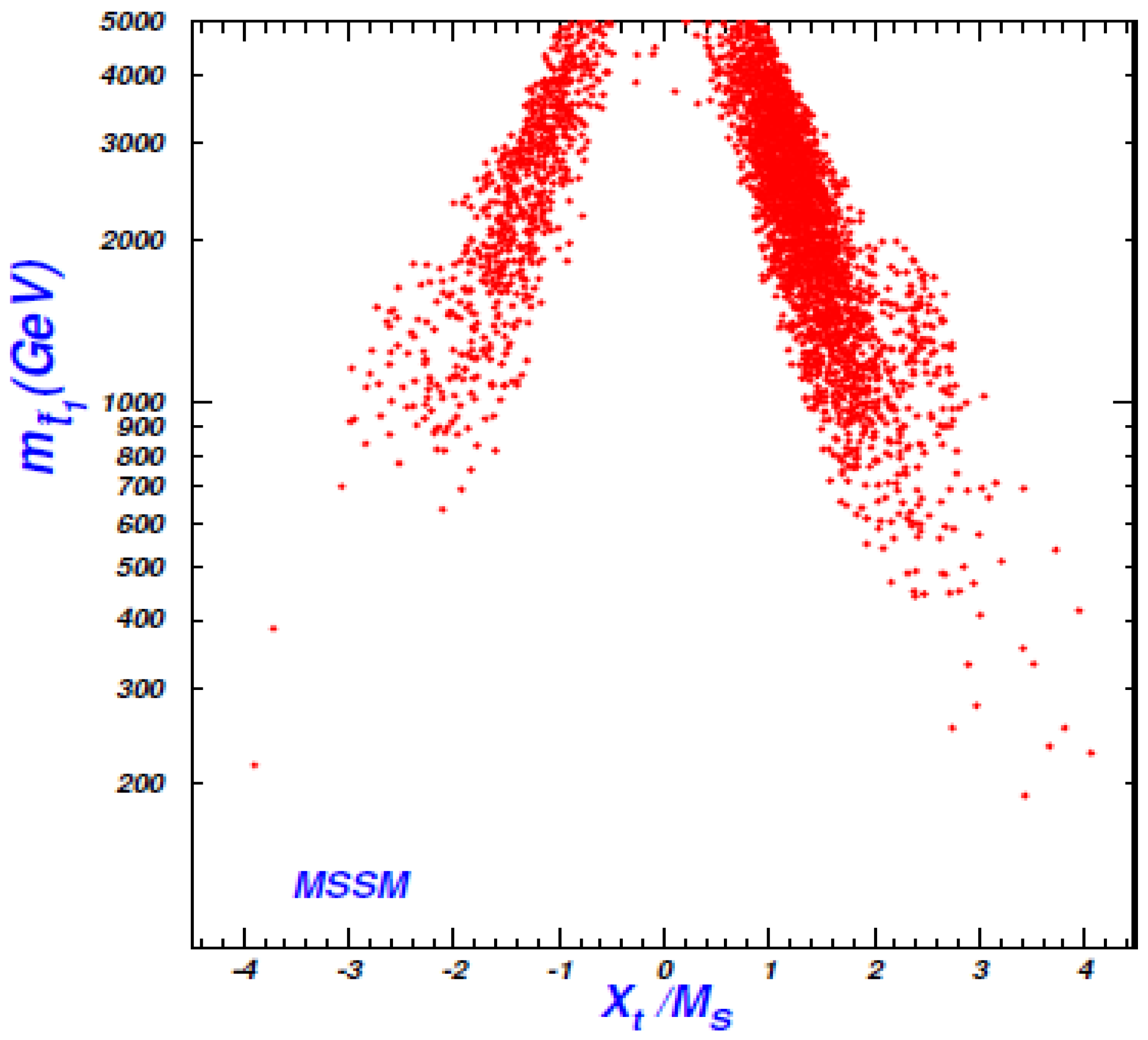
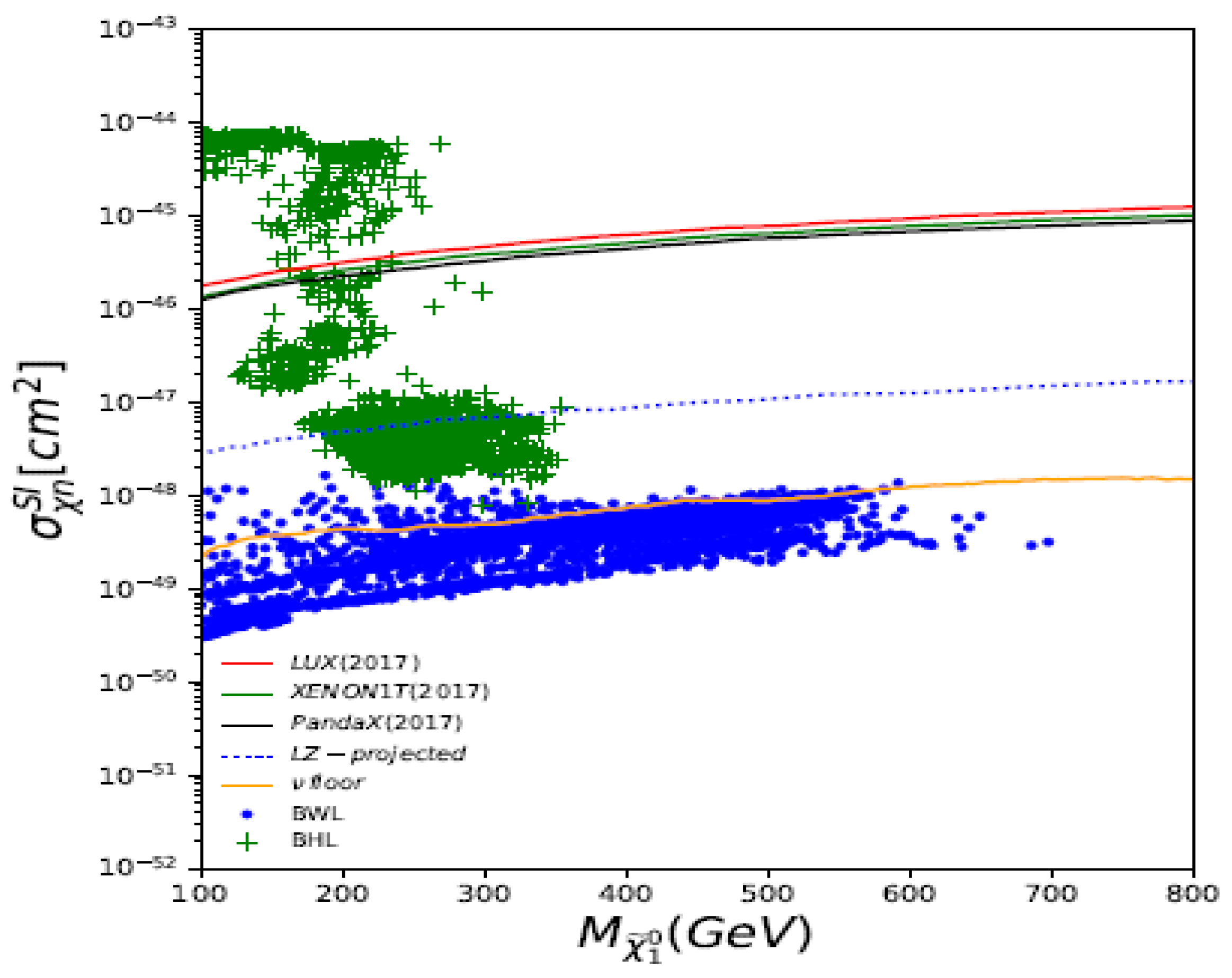
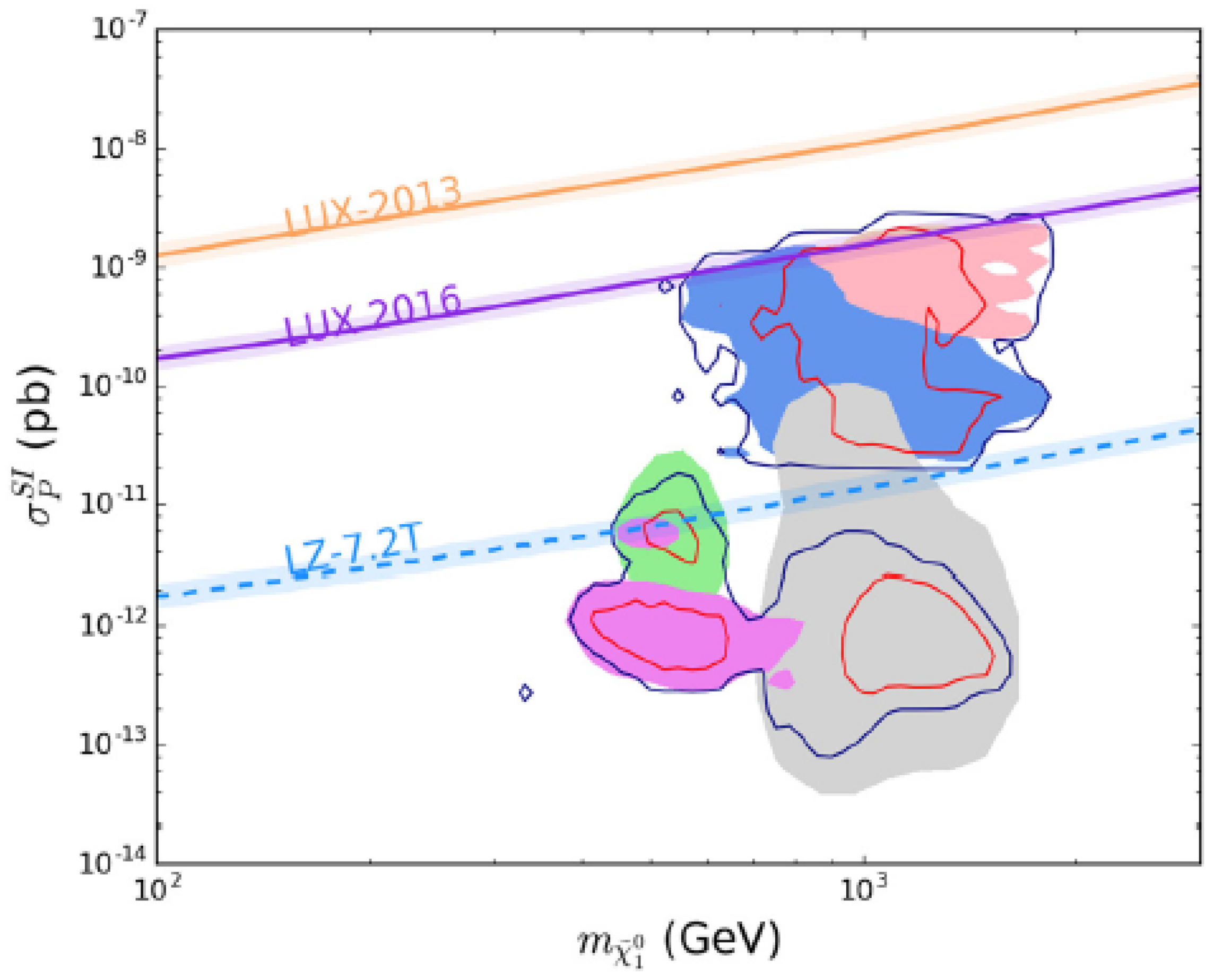
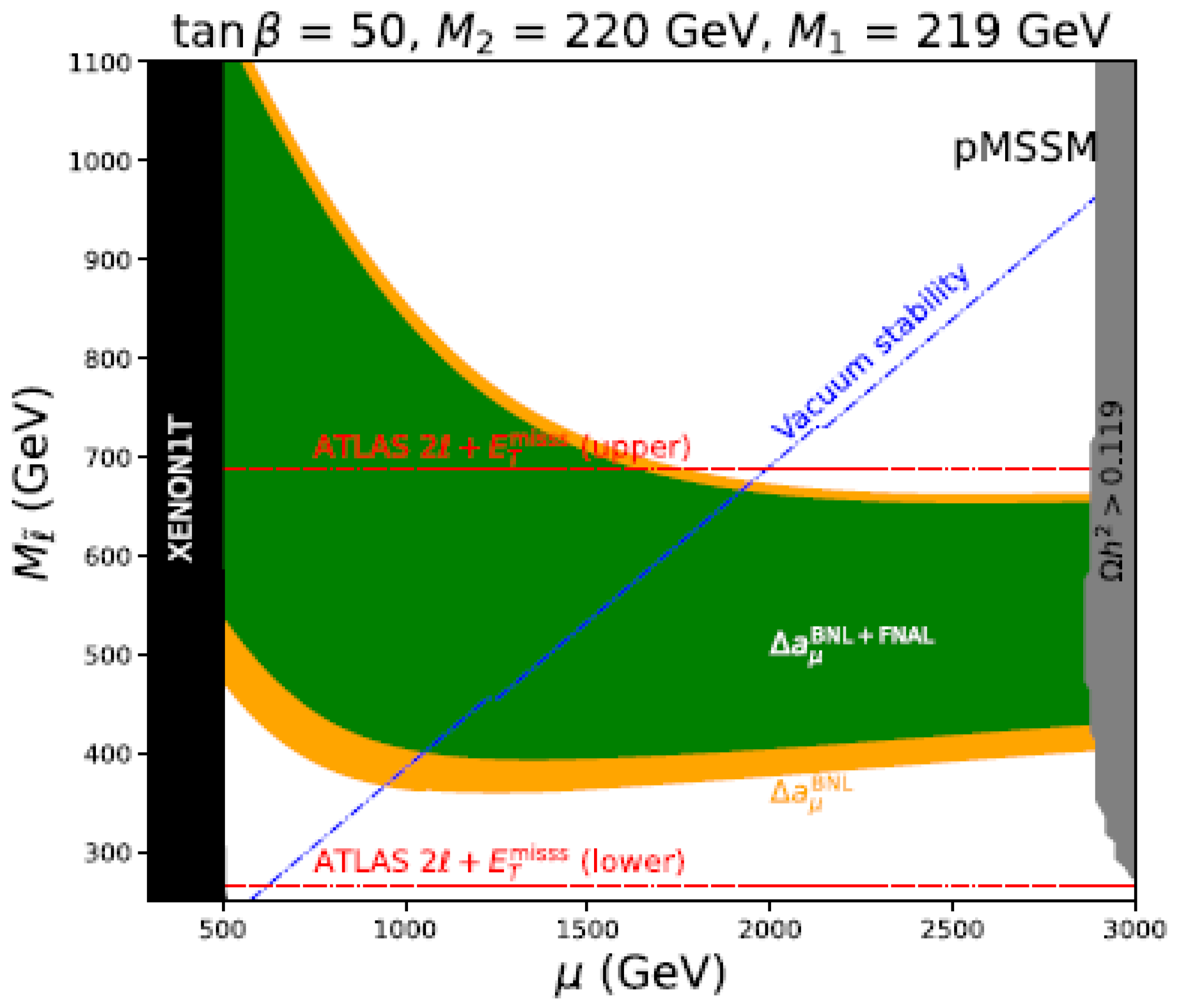
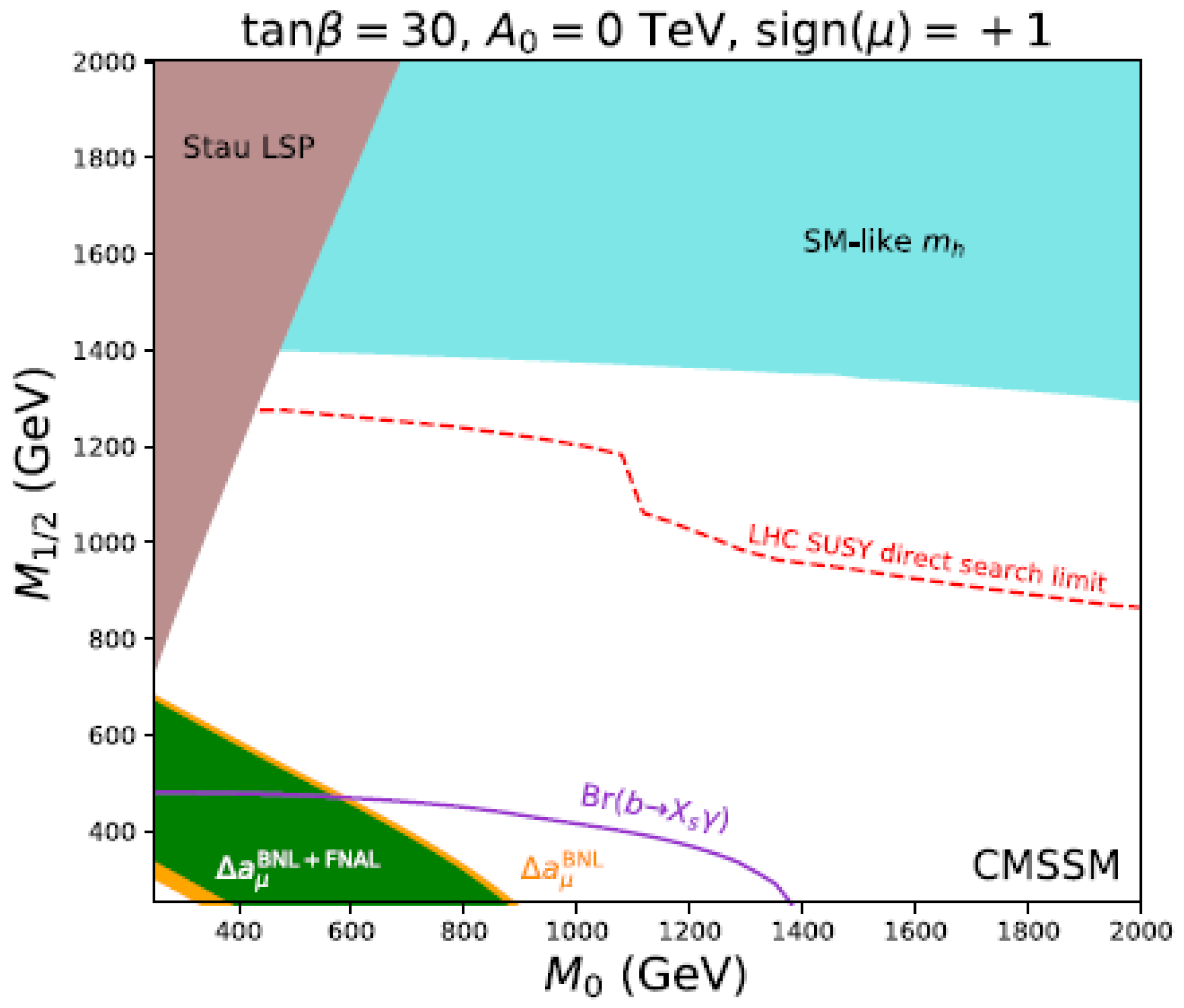
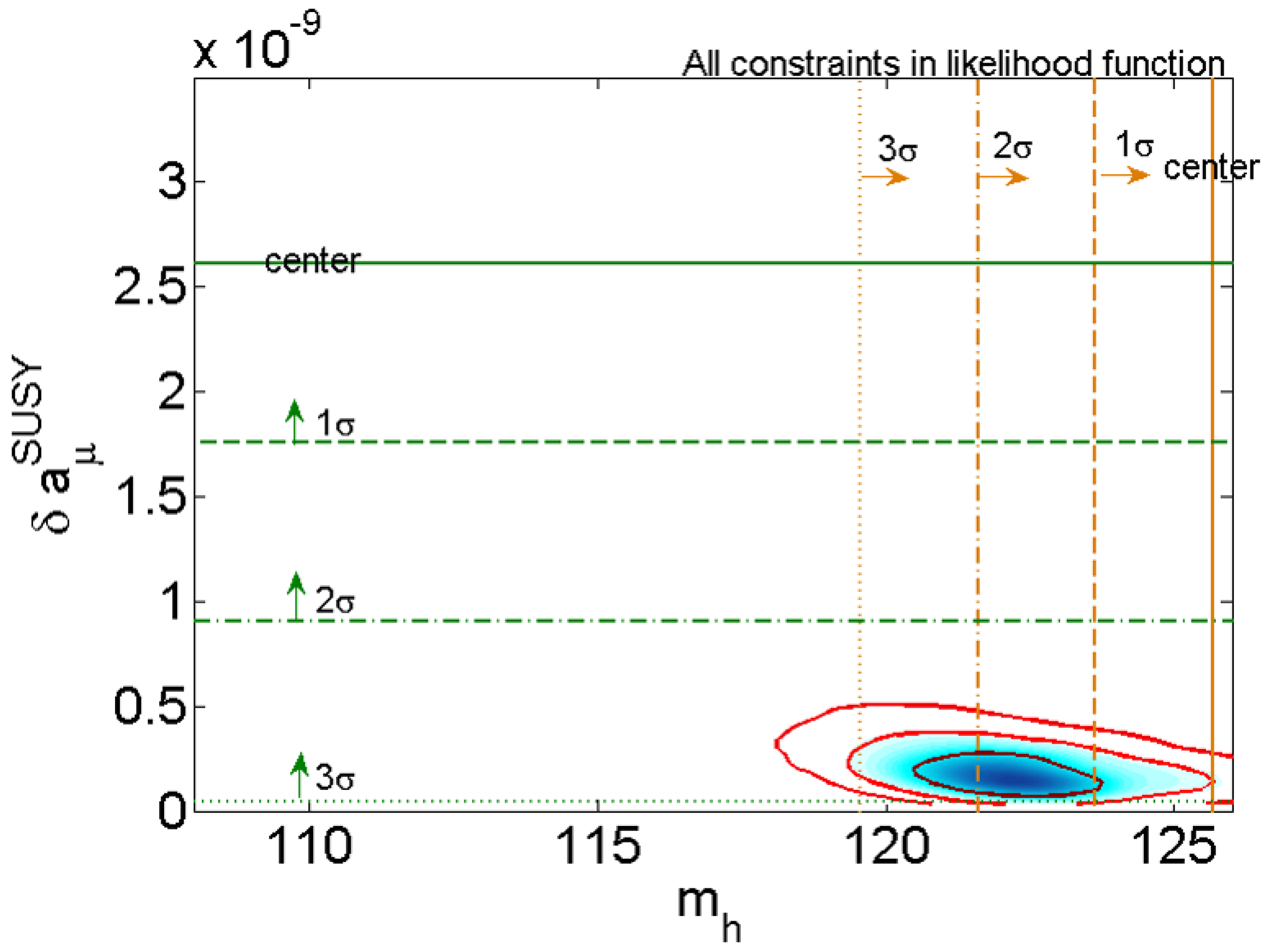
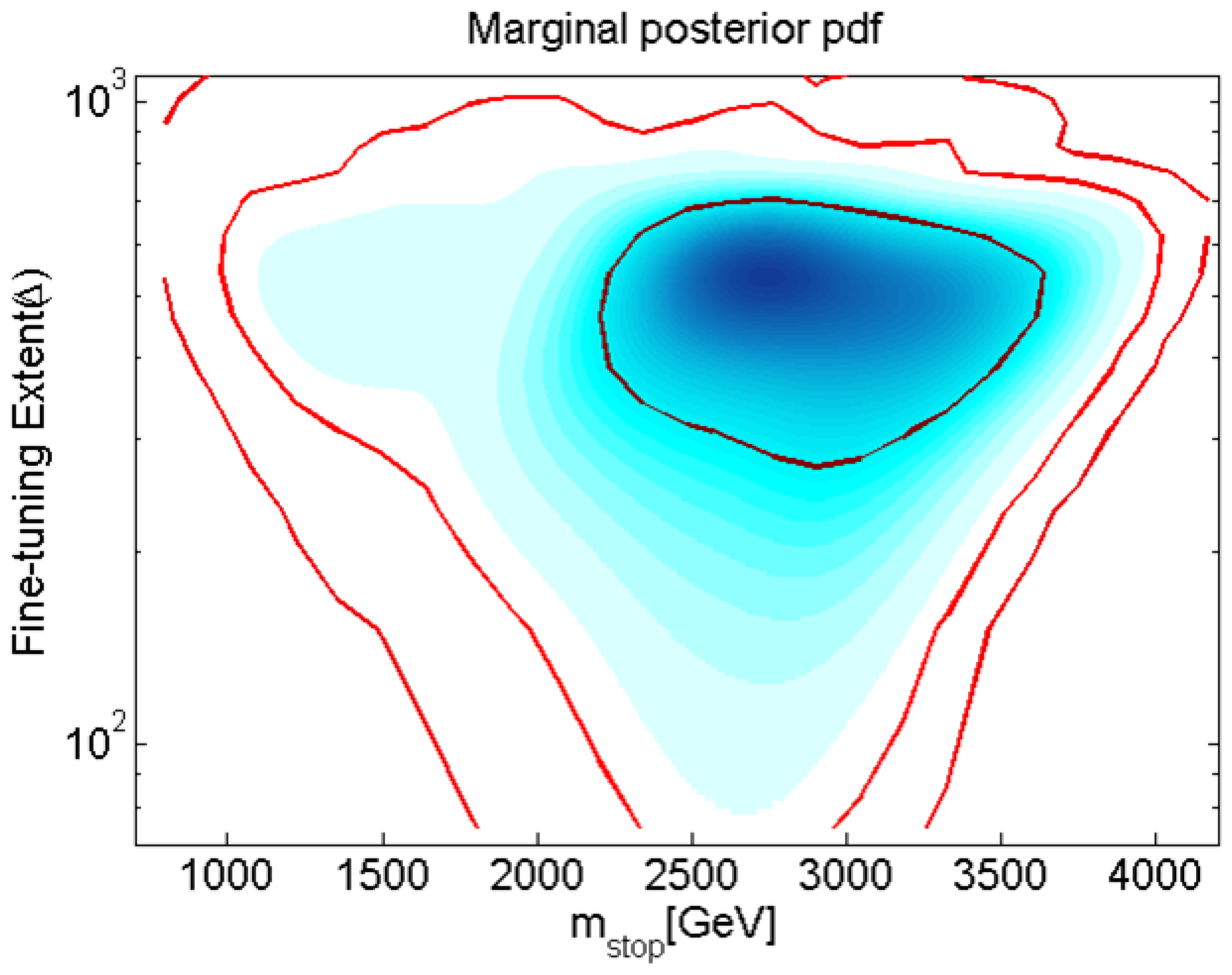
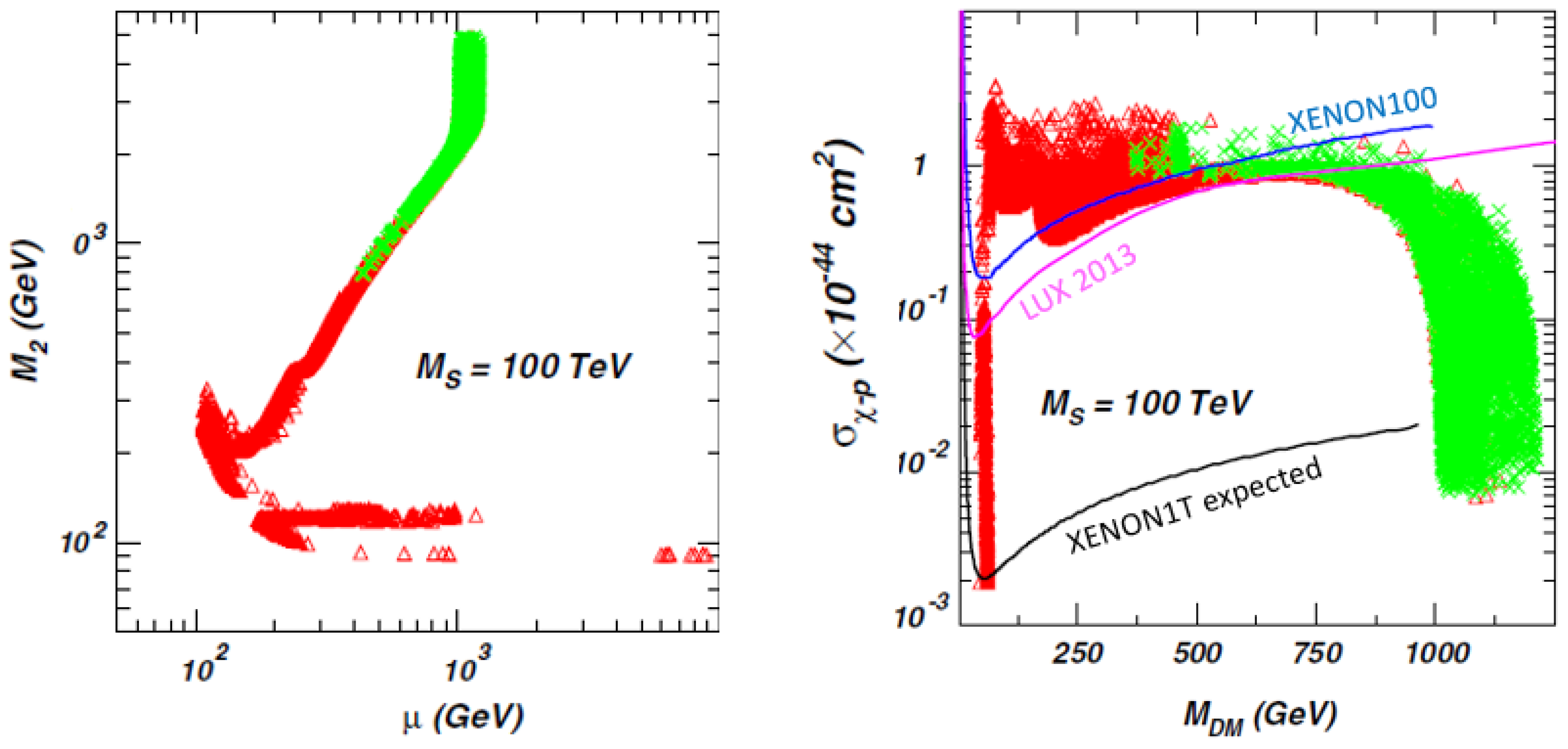
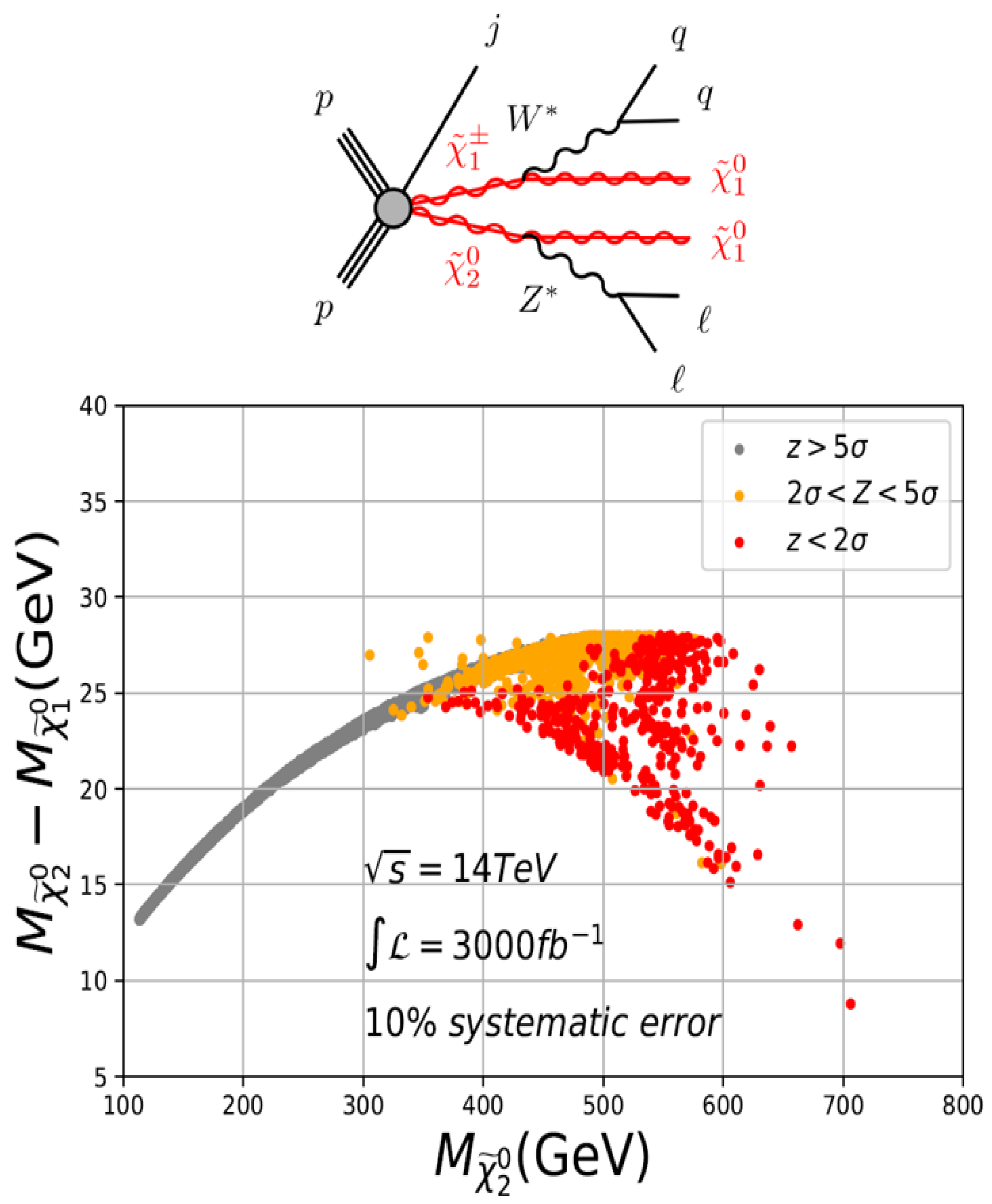
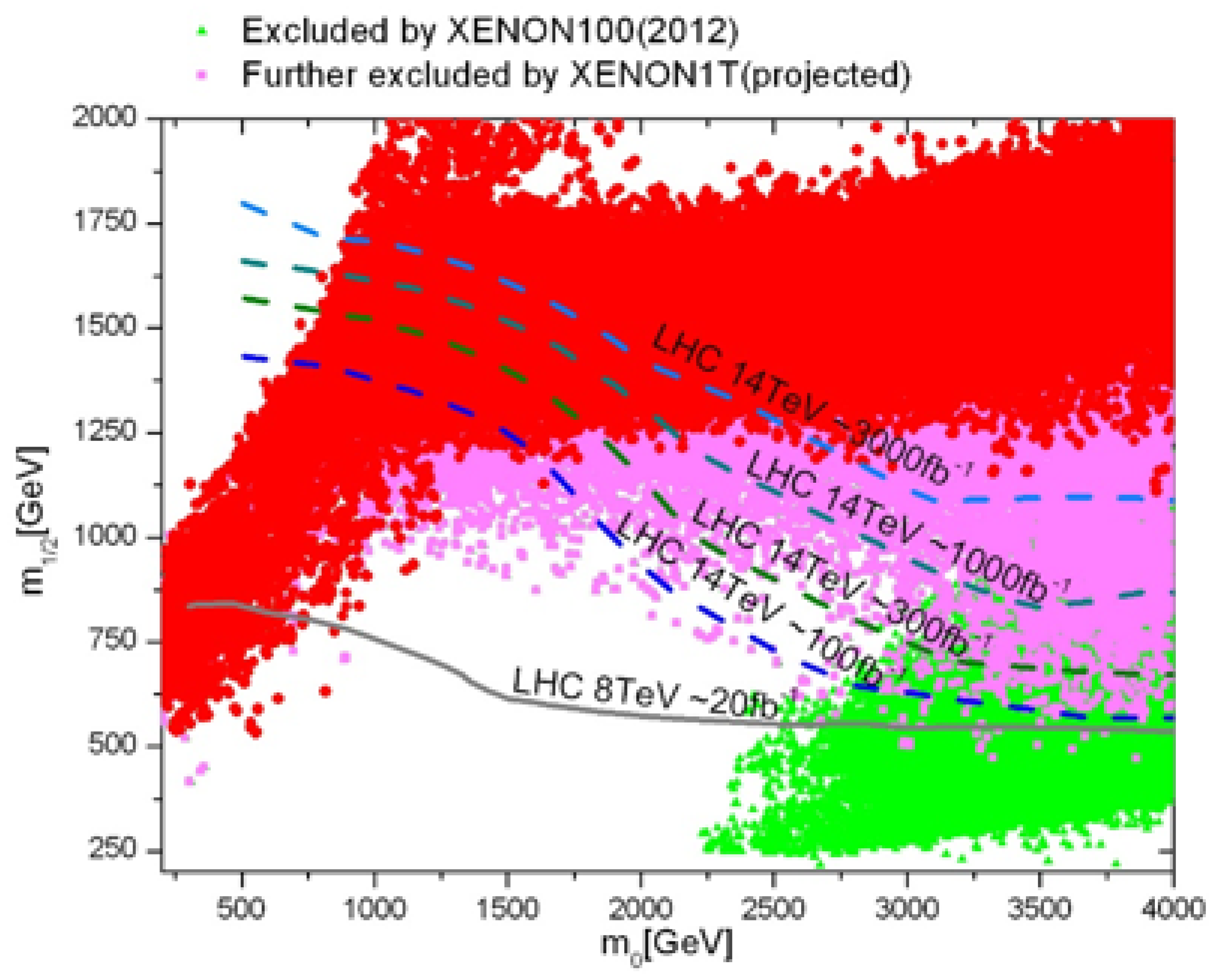
Publisher’s Note: MDPI stays neutral with regard to jurisdictional claims in published maps and institutional affiliations. |
© 2022 by the authors. Licensee MDPI, Basel, Switzerland. This article is an open access article distributed under the terms and conditions of the Creative Commons Attribution (CC BY) license (https://creativecommons.org/licenses/by/4.0/).
Share and Cite
Wang, F.; Wang, W.; Yang, J.; Zhang, Y.; Zhu, B. Low Energy Supersymmetry Confronted with Current Experiments: An Overview. Universe 2022, 8, 178. https://doi.org/10.3390/universe8030178
Wang F, Wang W, Yang J, Zhang Y, Zhu B. Low Energy Supersymmetry Confronted with Current Experiments: An Overview. Universe. 2022; 8(3):178. https://doi.org/10.3390/universe8030178
Chicago/Turabian StyleWang, Fei, Wenyu Wang, Jinmin Yang, Yang Zhang, and Bin Zhu. 2022. "Low Energy Supersymmetry Confronted with Current Experiments: An Overview" Universe 8, no. 3: 178. https://doi.org/10.3390/universe8030178
APA StyleWang, F., Wang, W., Yang, J., Zhang, Y., & Zhu, B. (2022). Low Energy Supersymmetry Confronted with Current Experiments: An Overview. Universe, 8(3), 178. https://doi.org/10.3390/universe8030178







